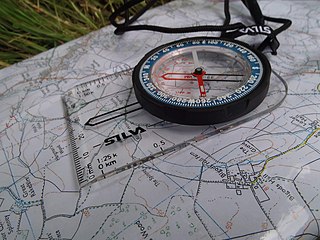
Orienteering is a group of sports that involve using a map and compass to navigate from point to point in diverse and usually unfamiliar terrain whilst moving at speed. Participants are given a topographical map, usually a specially prepared orienteering map, which they use to find control points. Originally a training exercise in land navigation for military officers, orienteering has developed many variations. Among these, the oldest and the most popular is foot orienteering. For the purposes of this article, foot orienteering serves as a point of departure for discussion of all other variations, but almost any sport that involves racing against a clock and requires navigation with a map is a type of orienteering.

The International Orienteering Federation (IOF) is the international governing body of the sport of orienteering. The IOF head office is located in Karlstad, Sweden. The IOF governs four orienteering disciplines: foot orienteering, mountain bike orienteering, ski orienteering, and trail orienteering.

The World Orienteering Championships is an annual orienteering event organized by the International Orienteering Federation. The first World Championships was held in Fiskars, Finland in 1966. They were held biennially up to 2003. Since 2003, competitions have been held annually. Participating nations have to be members of the International Orienteering Federation (IOF).

Silva Sweden AB is an outdoors products company that sells handheld compasses and other navigational equipment including GPS tools, mapping software, aircraft altimeters, and marine navigation tools. Silva's founders - Gunnar Tillander, Alvar Kjellström, Arvid Kjellström, and Björn Kjellström - invented the hugely popular orienteering baseplate or protractor compass used around the world for outdoors navigation.

Orienteering USA (OUSA), formerly United States Orienteering Federation (USOF), is the national governing body for orienteering in the United States. It is recognized by the International Orienteering Federation and the United States Olympic Committee. It was founded on 1 August 1971. Orienteering USA is a 501(c)(3) non-profit organization. There are 68 current member clubs and over 1,500 members.

The British Orienteering Federation Limited, generally known and branded as British Orienteering, is the national sports governing body for the sport of orienteering in the United Kingdom.

Ski orienteering (SkiO) is a cross-country skiing endurance winter racing sport and one of the four orienteering disciplines recognized by the IOF. A successful ski orienteer combines high physical endurance, strength and excellent technical skiing skills with the ability to navigate and make the best route choices while skiing at a high speed.

The Italian Orienteering Federation is the national orienteering federation of Italy. It is a full member of the International Orienteering Federation.
Björn Kjellström, originally from Sweden, was a ski orienteering champion in Sweden and co-founder of the compass manufacturing company Silva Sweden AB which produced the Silva compass. More than 25 million Silva compasses have been sold since the founding of the company.

A control point is a marked waypoint used in orienteering and related sports such as rogaining and adventure racing. It is located in the competition area; marked both on an orienteering map and in the terrain, and described on a control description sheet. The control point must be identifiable on the map and on the ground. A control point has three components: a high visibility item, known as a flag or kite; an identifier, known as a control code; and a recording mechanism for contestants to record proof that they visited the control point. The control point is usually temporary, except on a permanent orienteering course.

The Swedish Orienteering Federation is the national orienteering association in Sweden. It is recognized as the national federation for Sweden by the International Orienteering Federation, of which it is a member.
The Norwegian Orienteering Federation is the national Orienteering Association in Norway. It is recognized as the orienteering association for Norway by the International Orienteering Federation, of which it is a member. The association was founded 1 October 1945, and is a member of the Norwegian Confederation of Sports (NIF). Its first chairman was Kaare Thuesen. In 1946 NOF had 204 associated clubs, with just above 7,000 members. The number of clubs and associated members increased gradually through the 1950s, 1960s and 1970s, and peaked in 1984 with 630 clubs and 34,000 members, and 35,000 members and 620 clubs in 1985. The next twenty years saw a decline in the number of clubs and members. As per December 2007 Norges Orienteringsforbund had 400 associated clubs and just above 24,000 members, distributed over eighteen districts.

Foot orienteering is the oldest formal orienteering sport, and the one with the most "starts" per year. Usually, a FootO is a timed race in which participants start at staggered intervals, are individually timed, and are expected to perform all navigation on their own. The control points are shown on the orienteering map and must be visited in the specified order. Standings are determined first by successful completion of the course, then by shortest time on course.
Jan Alvar Kjellström was a Swedish orienteer who played an important role in the development of the sport of orienteering in Great Britain.
The Jan Kjellström International Orienteering Festival or "JK" is the premier domestic orienteering competition in the United Kingdom along with the British Orienteering Championships, usually held over the Easter Weekend.

Andrine Benjaminsen is a Norwegian orienteer and ski orienteer.

Kristian Jones or Kris Jones is a competitor in orienteering and athletics, competing for Great Britain. He also competes for Lillomarka OK in Norway, Forth Valley orienteers and Wales.

The North American Orienteering Championships (NAOC) is a biennial orienteering event organized by the International Orienteering Federation.

Ralph Street is a British orienteering competitor. He was part of the British team that came second in the sprint relay at the 2022 World Orienteering Championships. His team included Megan Carter Davies, Kris Jones and Charlotte Ward.















